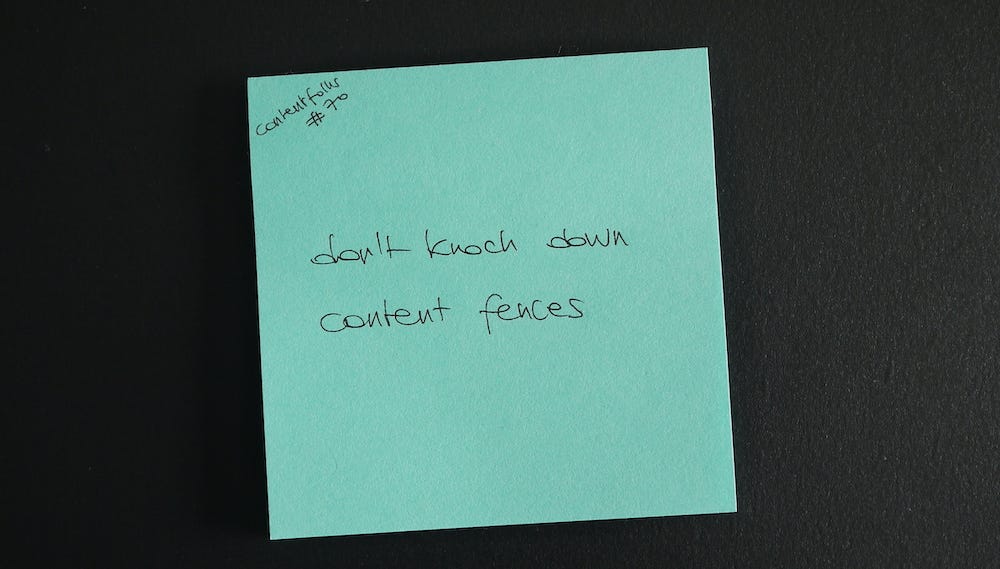cf #70: don’t knock down your content fences
You are reading contentfolks—a fortnightly blend of sticky notes, big content ideas, and small practical examples. Thank you for being here! ~fio
Hey there 👋
I started a new job this week as the Senior Content Strategist at Float, a company whose career page I’d had in my bookmarks since 2021 🥳
…and because of that, I’ve been re-reading ‘30-60-90 day’ guides on what to do (and how to do it) in your first quarter on a new team, including:
Eric Doty on his first 90 days at Dock, which I like because of the emphasis on setting up processes and starting to get things done asap
Parthi Loganathan on Letterdrop, which is a comprehensive read with a useful section about the 5 types of failure you can experience in a new role
Tracey Wallace on Workweek because I agree with her focus on audience interviews as a foundation for the rest of your content strategy
I don’t have a 30-60-90 guide of my own to share, but I do have a piece of general advice that applies to most new situations, job-related and otherwise: don’t knock down Chesterton fences.
The Chesterton fence principle
Back in 1929, G. K. Chesterton wrote:
“Let us say [… you find] a fence or gate erected across a road.
The more modern type of reformer goes gaily up to it and says, ‘I don’t see the use of this; let us clear it away.’
To which the more intelligent type of reformer will do well to answer: ‘If you don’t see the use of it, I certainly won’t let you clear it away. Go away and think. Then, when you can come back and tell me that you do see the use of it, I may allow you to destroy it.’”
In other words: when facing an existing system, don’t make changes until you understand why it’s there in the first place. This principle takes the name of ‘Chesterton’s fence’ and can be applied across many situations—including Wikipedia’s guidelines for deciding whether to nominate something for deletion:
Chesterton fences & content marketing
Whether you’re a new team member or a tenured employee, if you work in content you find yourself surrounded by fences all the time. Some are small- or medium-sized, like:
Individual content pieces or website pages that pre-date you
Existing analytics and reporting setups
Anything that makes you go “🤔 that’s an odd way of doing [thing]”
Some are large, like:
Website or information architecture
Tools you inherit from previous teammates
Processes and goals that were put in place before you showed up
These fences often feel like they’re there for no good reason and should be removed asap. To which my suggestion is: don’t. Before making any decision about a (content) fence, investigate why it’s there; if you do end up removing it, it should be after you’ve made sure you’re not going break anything.
💡 A practical example 💡
Since I literally started a new job 28 hours ago, I’ll spend the next few weeks reminding myself not to tear down any fences until I’ve figured out why they are there 😅 If and when you find yourself in the same spot, these questions can help guide our decision-making process:
Why is this [content piece, process, tool, external partner, agency, etc.] here?
Who was in charge of putting it here?
How did it get to its current state?
What problems did it solve?
What new problems could it cause if I removed it?
🔥 pro tip: this last point pairs well with the concept of second-order thinking, which is the ability to think through the consequences of an action or decision and also the consequences of those consequences.
Chesterton fences are everywhere. The next time you encounter one—whether it’s your first 30-60-90 days in a new role or you just stumbled upon something that feels odd or counterintuitive—remember that the smartest move is not knocking it down: it’s to get to the bottom of why it’s there first, and use that information to plan what you’re going to do next.
PS: inspired by a recent trip, here is an example of a literal fence you can encounter in the Scottish Highlands. If you wait patiently, you might even meet a hairy coo next to it.






Thanks for sharing this post! Keep posting - https://www.augustafencingcontractors.com/
loved this issue!